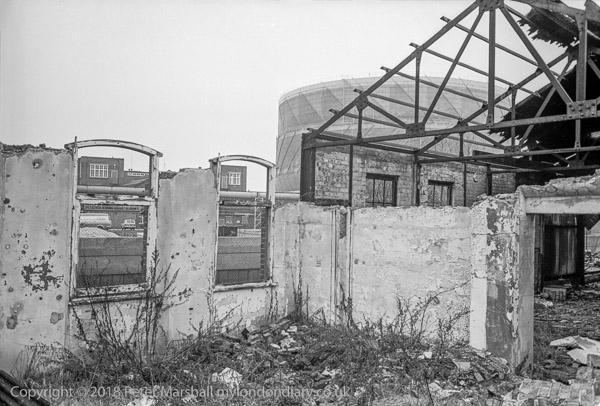London 1982
Peter MARSHALL

River Wandle, Wandsworth. 1982
30i-35: ruin, demolition, river, gas holder
Further upstream was a ruined works building which had lost most of its
roof and walls. Through it can be seen a clearer view of part of the gas
works site. This had been much larger at one time, covering most of the
area to the east of Wandle and with a large area beside the River Thames,
and maps show half a dozen gas holders.
The Wandsworth Gas Company was set up in 1834 following a meeting at the
Spread Eagle Inn, and bought a small site next to the Surrey canal where
barges could bring in coal. By 1835 it was producing gas, mainly for supplying
gas lights.
It prospered, and in the early years of the 20th century grew into one
of London's larger gas companies. The Wandle Canal could no longer handle
the 350,000 tonnes per year of coal required and it set up a wharf on
the River Thames for colliers from the North-East coalfields. Together
with buying its own colliers, SS Wandle the first in 1908, this enabled
it to supply gas at low prices, making it particularly important for large
scale users, including balloonists.
During the Great War, colliers came under attack, not least because gas
works were the main source of toluene, needed for the manufacture of TNT.
SS Wandle took on a German submarine which fired at her from on the surface
in 1916 and thought she had sunk the U-boat. The ship was met by cheering
crowds as they came up the Thames. Some researchers now think that the
sub had simply submerged and was only lost over a year later. SS Wandle
also sank in 1917, but the crew were rescued. There were two later colliers
of the same name, as well as a number of others. Various mergers and takeovers
meant that by the time of nationalisation in 1949, the Wandsworth and
District Gas Company was serving most of South-West London.